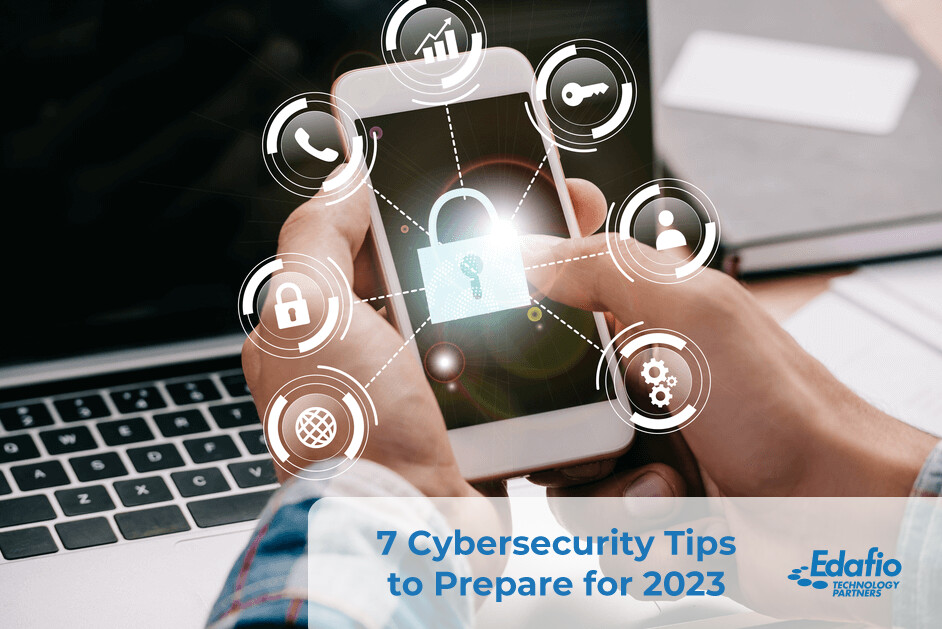Cybercrime continues to be one of the biggest threats to a business’s success. From a worldwide pandemic that decentralized entire workforces to ongoing shifts to virtualized I.T. environments and the increase of artificial intelligence (A.I.) and machine learning, cybercriminals have a perfect storm. In fact, the FBI expects cybercrime to double between 2023 and 2027. To combat these growing threats, 85 percent of small- and medium-sized enterprises plan to increase their cybersecurity spending in the year ahead (McKinsey).
Benjamin Franklin once said, “an ounce of prevention is worth a pound of cure.” Franklin was advocating for fire safety, but the concept applies to any threat, including cybersecurity. Preventative measures to avoid a problem are more manageable and less costly than fixing it after it occurs. To help your company be proactive, incorporate these seven tips into your technology operations to reduce risk and minimize fallout (should the worst happen).
Tip 1. Backup Sensitive Data and Systems
If backing up critical data and systems isn’t already a routine part of your business’s operations, make 2023 the year you start. Not only do regular backups protect against data loss, theft, and damage from cyberattacks, but they can also be the difference between quickly restoring your systems or having to pay a ransom.
Tip 2. Keep Software and Systems Updated
Updating your business’s software and systems helps address vulnerabilities that could be exploited by attackers. Updates often include security patches that address system-wide vulnerabilities and fix known issues, thus reducing the risk of a successful cyberattack. Additionally, regular updates can improve the overall performance, stability, and security of your business’s software and systems, helping to keep them protected against new and evolving threats.
Failing to install updates as soon as they are available can leave your systems open to exploitation by attackers. From security breaches to data theft, un-patched vulnerabilities in outdated software and systems continue to be one common strategy that cybercriminals use when targeting unsuspecting victims.
Tip 3. Train Your Employees
A business’s employees are often its first line of defense against cyberattacks, and their actions can significantly impact the outcome. Yet, many companies neglect to give these gatekeepers the information they need to identify and prevent a potential cyberattack. Edafio routinely provides employee training for our clients and has seen firsthand how it improves their overall information security posture and minimizes the risk of a successful breach.
Regular training on information security best practices, such as:
- How to identify phishing scams
- What makes a password strong
- Why use multi-factor authentication
- How to avoid risky behavior online
will empower your employees to approach information security with a proactive attitude. Additionally, regular training keeps employees updated on emerging threats and trends and helps them understand the importance of being safe online and their role in protecting the business from cyberattacks.
Tip 4. Implement Strong Password Policies and Use Multi-Factor Authentication (MFA)
A car thief might walk around a mall parking lot discretely checking for an unlocked door handle: cybercriminals create bots that can detect security vulnerabilities. Strong passwords and multi-factor authentication (MFA) effectively improve information security. Strong passwords, which are long, unique, and include a combination of letters, numbers, and symbols, make it difficult for attackers to “guess” or crack login credentials.
MFA adds an extra layer of security by requiring users to provide two or more forms of authentication, such as a password and a security token, to access systems and data. This makes it much more difficult for attackers to gain unauthorized access, even if they have obtained a user’s password. By implementing strong passwords and MFA, businesses can reduce the risk of a successful cyberattack and protect their sensitive data and systems.
Tip 5. Segment Your Networks
Segregating sensitive data and systems from the rest of the network can limit the damage of a successful cyberattack. By physically or logically separating sensitive information from other parts of the network, businesses can reduce the risk of a successful attack spreading and causing widespread damage across networks. Should an attacker break in, they can only access a limited subset of your data and systems.
Additionally, segmenting your networks will help your business comply with federal and state regulatory requirements and data protection industry standards. For example, if your company sells products in both the United States and France, having separate networks for each location will ensure you comply with the European Union’s General Data Protection Regulation (GDPR) and reduce the risk that both your networks become compromised.
Tip 6. Implement Endpoint Protection Software
Endpoint protection software is an effective way to prevent malware infections. The software runs on endpoint devices (laptops, desktops, and mobile devices) and monitors for signs of malicious activity, such as malware downloads and suspicious network connections. When it detects malicious activity, the software can prevent the malware from executing, quarantine the file, or remove it from the system.
Tip 7. Have an Incident Response Plan
No business wants to think about being attacked and losing everything they have worked hard to achieve. However, being caught unprepared with no processes in place ensures an attack will wreak havoc. Cybercrimes happen 24/7/365 to businesses of all types and sizes. A robust incident response plan that you routinely update is like wearing your seatbelt in a car: once you get in the habit, it can be your saving grace should the unthinkable occur.
As technology evolves, new threats will emerge—many of which are unknown outside of the I.T. industry. For non-IT business leaders and owners who have been managing their company’s technology, it’s important to recognize the inflection point of when it’s time to bring in experts. Whether that point is investing in a new technology stack or receiving funding to develop a new product, an expert consultant will ensure information security is built into the foundation of your business.
Want to know how strong your organization’s security is? Take Our Assessment To Find Out.
Contact Edafio Technology Partners today and speak to a security specialist about how we build intelligent technology solutions. As one of the nation’s top-ranking managed services provider (MSP), Edafio’s team of 100+ certified engineers and specialists helps our clients reach their business goals by ensuring network safety and integrity.
READY TO GET STARTED?
Make an Informed, Scalable Decision with Edafio








